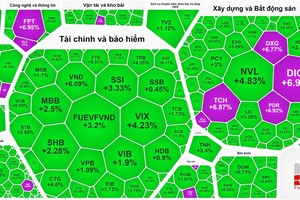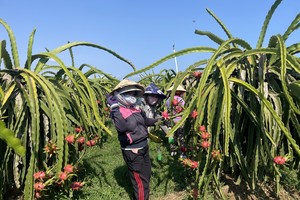 Traditional taxis wait for passengers in Tan Son Nhat Airport. (Photo: SGGP)
Traditional taxis wait for passengers in Tan Son Nhat Airport. (Photo: SGGP)
Many inadequacies have not been resolved
Ride-hailing apps first appeared in Vietnam six years ago and immediately gained the upper hand in the competition with traditional taxis. Customers benefit from cheaper fares, knowing the cost of the trip in advance, and having the choice to take a cab or not. Drivers also benefit from higher operating efficiency, less time of running empty on the road, and taking advantage of idle personal vehicles.
However, how many years that app-based taxis operate are many years that traditional taxis call for help because these two types of transport have the same nature of carrying passengers, and fares being calculated based on kilometers, but they have different business conditions. Traditional taxis are subject to strict regulations on fares, vehicle identification, the number of vehicles, tax obligations, and responsibilities to employees. Meanwhile, tech-based taxis enjoy more comfortable conditions without vehicle identification, flexible fares, flat tax payment, and no insurance for employees.
After five years of drafting and 12 times of changes, by 2020, Decree No.10/2020/ND-CP, which replaces Decree No.86/2014/ND-CP on business and conditions for transport business by cars, was promulgated. The Ministry of Transport has identified app-based taxis as a transport business unit instead of simply providing applications. However, Decree No.10 has not yet completely resolved the inadequacies between the two types of taxis, and the war continues.
According to a representative of the Department of Transportation under the Ministry of Transport, app-based taxis and traditional taxis have the same nature, but the fact that they are subject to two different management conditions is unreasonable and unfair. Therefore, in the revised draft Law on Road Traffic submitted to the Government, the Ministry of Transport plans to aggregate all under-nine-seater vehicles into taxis. If approved, tech-based taxis will have to declare fares, have vehicle identification stickers, pay tax, and be responsible to employees like traditional taxi companies.
Need a new way of management
In the face of the information that the Ministry of Transport wanted to combine tech-based and traditional taxis into the same type, most taxi businesses and traditional taxi associations expressed their agreement, thinking that it would create a fair business environment for transportation businesses. Mr. Nguyen Cong Hung, Chairman of the Hanoi Taxi Association, affirmed that traditional taxi businesses had suffered unfairness in business conditions compared to app-based taxis for many years. Many taxi companies have struggled and been on the verge of bankruptcy because they cannot compete with tech-based taxis. Technology application to business is necessary, but taking advantage of technology to circumvent the law and compete unhealthily is unacceptable. Mr. Nguyen Van Thanh, former Chairman of the Vietnam Automobile Association, also said the fact that all under-nine-seater cars were called taxis would overcome the shortcomings in fare management and conditions to enter the market, pay taxes, and establish traffic safety management process. It will create fair competition for traditional taxi companies.
However, besides supportive opinions, many consumers said that if all of them are called a taxi for management, how much benefit of tech-based taxis will remain? Tech-based taxis offer cheaper fares, and passengers will no longer worry about being overcharged or being cheated of fares by rigged taxi meters like traditional taxis. And then, do traditional taxis still have many motivations to upgrade, transform management methods, and apply new technologies to improve fares and service quality? In fact, in the context of a sharp increase in gasoline prices recently, taxi services have been messy. Many app-based drivers have had to sell their cars or suspend operations, causing the number of app-based taxis to decrease significantly. As a result, it is more difficult for customers to call a cab, and fares are higher. Traditional taxis have more customers, but customers, of course, also have to accept to pay according to the meter with frustration. Some taxi companies even take advantage of the scarcity of taxis to link up with car owners outside the company to sell the passengers to them. Many passengers complained that they called a taxi through the hotline but were sent a car outside the company with a vague way of fare charging.
According to economic expert Vu Dinh Anh, it does not matter whether to aggregate passenger cars under nine seats into a taxi or not. The matter is how to manage it to suit the new situation. The Ministry of Transport cannot manage tech-based taxis as it has managed traditional taxis and vice versa. Many taxi companies have been actively applying technology in management and administration to increase competitiveness. The important goal of the law amendment is to create a fair competition environment while promoting the benefits of technology, and above all, to ensure the legitimate interests of consumers.
Ride-hailing apps first appeared in Vietnam six years ago and immediately gained the upper hand in the competition with traditional taxis. Customers benefit from cheaper fares, knowing the cost of the trip in advance, and having the choice to take a cab or not. Drivers also benefit from higher operating efficiency, less time of running empty on the road, and taking advantage of idle personal vehicles.
However, how many years that app-based taxis operate are many years that traditional taxis call for help because these two types of transport have the same nature of carrying passengers, and fares being calculated based on kilometers, but they have different business conditions. Traditional taxis are subject to strict regulations on fares, vehicle identification, the number of vehicles, tax obligations, and responsibilities to employees. Meanwhile, tech-based taxis enjoy more comfortable conditions without vehicle identification, flexible fares, flat tax payment, and no insurance for employees.
After five years of drafting and 12 times of changes, by 2020, Decree No.10/2020/ND-CP, which replaces Decree No.86/2014/ND-CP on business and conditions for transport business by cars, was promulgated. The Ministry of Transport has identified app-based taxis as a transport business unit instead of simply providing applications. However, Decree No.10 has not yet completely resolved the inadequacies between the two types of taxis, and the war continues.
According to a representative of the Department of Transportation under the Ministry of Transport, app-based taxis and traditional taxis have the same nature, but the fact that they are subject to two different management conditions is unreasonable and unfair. Therefore, in the revised draft Law on Road Traffic submitted to the Government, the Ministry of Transport plans to aggregate all under-nine-seater vehicles into taxis. If approved, tech-based taxis will have to declare fares, have vehicle identification stickers, pay tax, and be responsible to employees like traditional taxi companies.
Need a new way of management
In the face of the information that the Ministry of Transport wanted to combine tech-based and traditional taxis into the same type, most taxi businesses and traditional taxi associations expressed their agreement, thinking that it would create a fair business environment for transportation businesses. Mr. Nguyen Cong Hung, Chairman of the Hanoi Taxi Association, affirmed that traditional taxi businesses had suffered unfairness in business conditions compared to app-based taxis for many years. Many taxi companies have struggled and been on the verge of bankruptcy because they cannot compete with tech-based taxis. Technology application to business is necessary, but taking advantage of technology to circumvent the law and compete unhealthily is unacceptable. Mr. Nguyen Van Thanh, former Chairman of the Vietnam Automobile Association, also said the fact that all under-nine-seater cars were called taxis would overcome the shortcomings in fare management and conditions to enter the market, pay taxes, and establish traffic safety management process. It will create fair competition for traditional taxi companies.
However, besides supportive opinions, many consumers said that if all of them are called a taxi for management, how much benefit of tech-based taxis will remain? Tech-based taxis offer cheaper fares, and passengers will no longer worry about being overcharged or being cheated of fares by rigged taxi meters like traditional taxis. And then, do traditional taxis still have many motivations to upgrade, transform management methods, and apply new technologies to improve fares and service quality? In fact, in the context of a sharp increase in gasoline prices recently, taxi services have been messy. Many app-based drivers have had to sell their cars or suspend operations, causing the number of app-based taxis to decrease significantly. As a result, it is more difficult for customers to call a cab, and fares are higher. Traditional taxis have more customers, but customers, of course, also have to accept to pay according to the meter with frustration. Some taxi companies even take advantage of the scarcity of taxis to link up with car owners outside the company to sell the passengers to them. Many passengers complained that they called a taxi through the hotline but were sent a car outside the company with a vague way of fare charging.
According to economic expert Vu Dinh Anh, it does not matter whether to aggregate passenger cars under nine seats into a taxi or not. The matter is how to manage it to suit the new situation. The Ministry of Transport cannot manage tech-based taxis as it has managed traditional taxis and vice versa. Many taxi companies have been actively applying technology in management and administration to increase competitiveness. The important goal of the law amendment is to create a fair competition environment while promoting the benefits of technology, and above all, to ensure the legitimate interests of consumers.
























